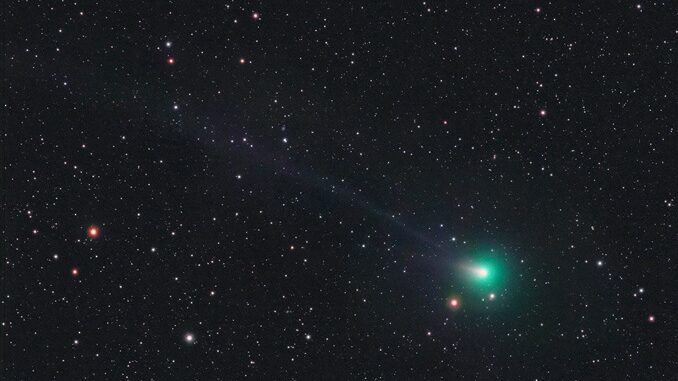
This year promises a flurry of comets that have the potential to reach binocular or small telescope viewing brightness. The most promising being that of recently discovered Comet PanSTARRS (C/2021 03). Read our list below for more details of comet observing prospects in 2022.
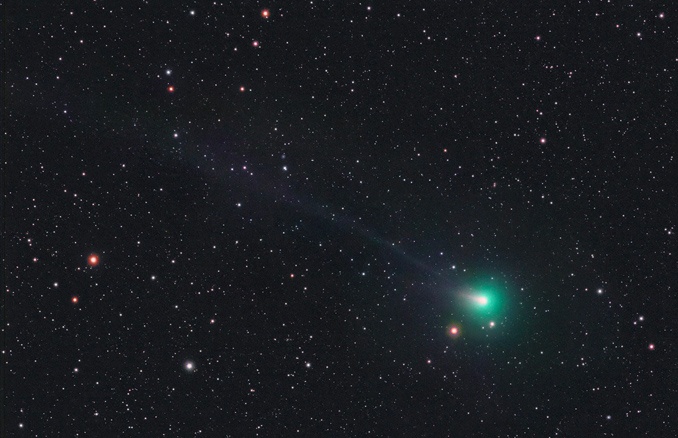
Borrelly’s Comet as it’s been commonly known is a periodic comet which orbits the Sun once every 6.85 years. Discovered back in 1904 by French astronomer Alphonse Borrelly in Marseilles, this comet was visited by the Deep Space 1 spacecraft in 2001.
19P/Borrelly reached closest approach to Earth last year on 11 December, however perihelion, (closest approach to the Sun), occurred on 01 February, 2022. Residing in Pisces at the time, Borrelly reached magnitude 9. The comet then slowly faded to magnitude 10 as the ball of ice headed through Aries and Perseus through March. Fading further, the comet heads through Auriga and straddles along the constellation of Lynx through June by which time, the comet will have faded to magnitude 14.
(C/2021 F1) Lemmon-PanSTARRS
Lemmon-PanSTARRS is a comet discovered last year which promised a brightness of magnitude 9. Not something to write home about but was certainly worth a look in a telescope or binoculars. The comet reached closest approach to Earth on 12 February and reached peak brightness on 03 April in the constellation of Pisces. Perihelion occurred soon after on 06 April.
Lemmon-PanSTARRS has now faded to magnitude 13.1 residing in the southern constellation of Eridanus.
(C/2019 L3) Atlas
Comet C/2019 LS Atlas also reached magnitude 9 as it travelled through the constellation of Gemini through January. The comet reached closest approach to Earth on 06th January and perihelion on 09 January.
At a distance of 386 million kilometres at closet approach to Earth, this comet certainly didn’t intend on coming close to home. As a result of this vast distance, the object looked rather small in modest-sized telescopes featuring a small tail. At the end of March the comet remained at magnitude 10 still in the constellation of Gemini headed for Orion.
(C/2021 O3) PanSTARRS
Comet C/2021 O3 PanSTARRS is another comet discovered last year with the promise of brightness above the magnitude 10 threshold. Brightness predictions for this new visitor have been a little tricky due to it being a recent arrival from the Oort cloud.
After peaking at magnitude 9 in late April, the comet reached closest approach to Earth on 08 May, 2022 in the constellation of Perseus, 17 days after perihelion. Now circumpolar, C/2021 O3 resides in Ursa Minor headed for Draco in mid-June-July.
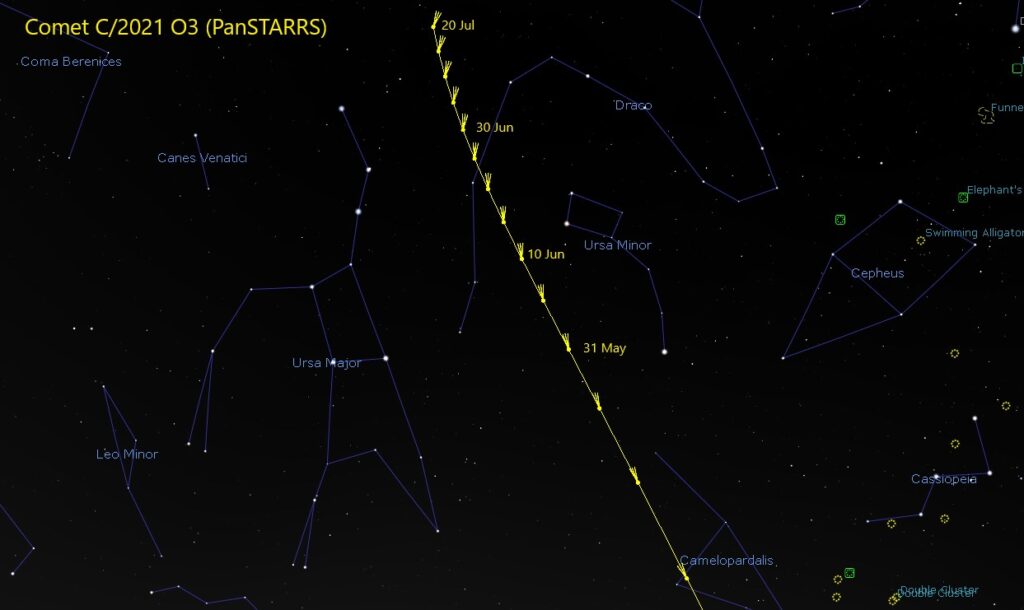
(C/2021 P4) Atlas
Comet C/2021 P4 Atlas is our third comet in the list that was discovered last year. It is also the second comet featured here that was discovered by ATLAS; an asteroid early warning project developed by the University of Hawaii and funded by NASA.
Comet Atlas C/2021 P4 is predicted to reach a moderately bright magnitude 10 as it glides through the constellations of Lynx, Cancer and Leo through mid-June-July. Closest approach to Earth will be on 13 July, 2022 at a distance of 293 million kilometres followed by perihelion on 30 July. The comet will be low in the northwestern sky during it’s brightest appearance and summer twilight will hinder viewing.
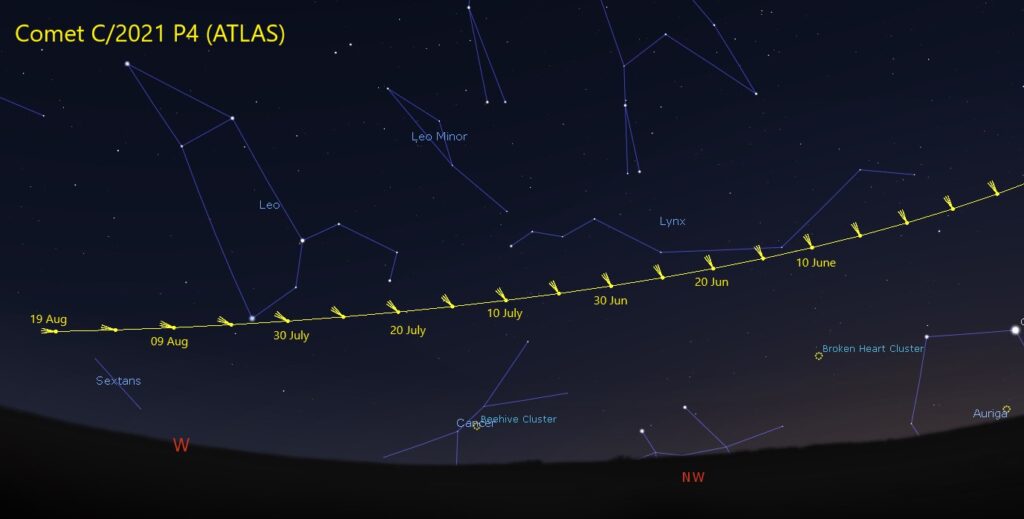
Comet ZTF (C/2022 E3 )
This comet is currently a dim 14th magnitude fuzz ball in the constellation of Delphinus (as of 20th June 2022). However, this is certainly one to watch. Current predictions put the comet at reaching 6th magnitude early next year. This puts Comet ZTF just within the realms of naked eye visibility.
As for this year’s prospects, Comet (C2022/ E3) ZTF is predicted to reach magnitude 8.5 by Christmas before heading to perihelion on 13 January, 2023.
The path of comet ZTF
Comet ZTF will continue it’s journey slowly moving from Delphinus in to Lyra in June and July then on in to Hercules through August. This is a well-placed position for observers in the northern hemisphere with Hercules being high up in the sky. At this point, the comet will be a slightly easier telescopic object hovering around magnitude 13.
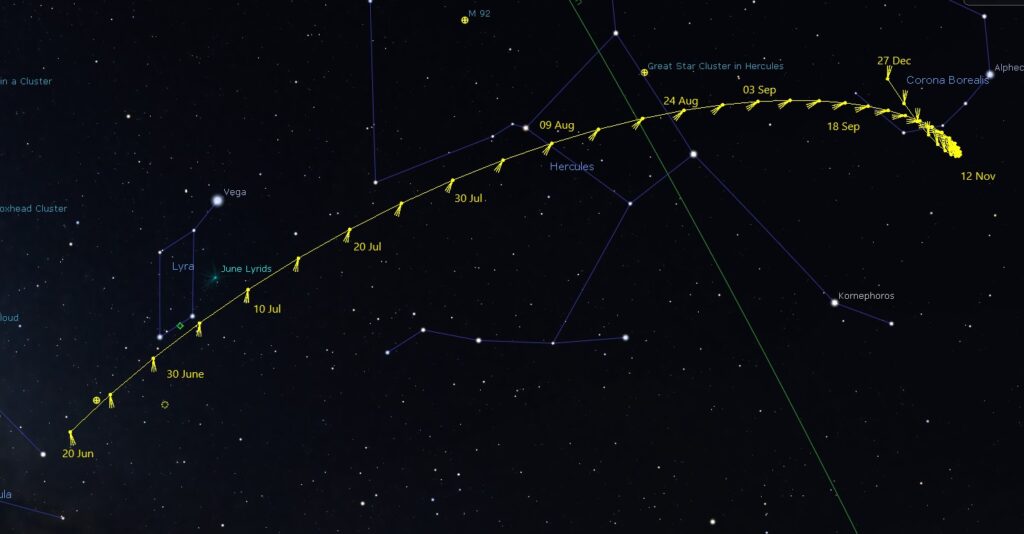
Through the autumn, the comet continues on towards the constellation of Corona Borealis slowly brightening as it goes. Comet ZTF remains in Corona Borealis for the rest of the year on in to January for perihelion. Then on February 2, 2023, Comet ZTF reaches closest approach to the Earth where it is predicted to reach magnitude 6.5, easily visible in binoculars of all sizes and visible to the naked eye from some dark sites.
